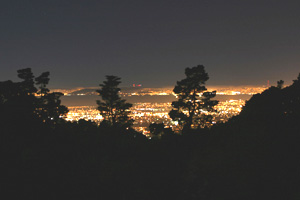 A dark-sky spot amidst the urban light
A dark-sky spot amidst the urban light
pollution of the Bay Area, taken from
Chabot Space & Science Center. Credit:
Carter Roberts. When I was growing up, I spent my summers at a camp in the Sierra’s near Colfax, where my mother worked as head cook. This gave me two months' worth of nights every year under dark, sparkling skies far from the glare of the city lights. The sky bristled with stars beyond counting.
Back home in Oakland, then and now, the urban nighttime glow drowns out all but a few of the brightest stars. The official term for this condition is light pollution: the reflection, or scattering, of urban light from the atmosphere above that turns the night sky into a pale ghost of daytime. To get an idea just how bad light pollution is at your location, the next time you take a look at the night sky, try to count the stars. If you come up with 10 or 20, then you've got light pollution problems.
Fortunately, Bay Area geology offers refuge for those who want to see the stars closer to how nature intended. Like "microclimates" of relative darkness, pockets and swaths of shadow created by regional hills and mountains provide stargazers with habitat without having to drive a hundred miles.
So where can you go? There are many good places, but here’s my A-list of places I have actually gone to for stargazing:
- In the North Bay, the mountains and backroads around the Napa and Cotati valleys offer shelter from the lights. West of the Cotati Valley, all the way to the Bodega Bay and Point Reyes areas, it’s sparsely populated and fertile sky for star gazing.
- In the South Bay and Peninsula, the Santa Cruz Mountains may be the best in terms of dark skies—though trying to find a spot clear of tall trees can be challenging. The drive northward along Skyline Boulevard, especially the stretch south of Highway 92, offers many opportunities to pull over and park with little or no tree cover. Also, Henry Coe State Park [http://www.coepark.org/] near Morgan Hill has the advantage that its gates never close.
- In the East Bay, the Oakland-Berkeley Hills are lined with good ideas: Tilden Park in Berkeley, Sibley Volcanic Preserve just south of the Caldecott Tunnel, Chabot Space & Science Center in Oakland (with Friday and Saturday night free telescope viewing!), and Anthony Chabot Regional Park east of San Leandro—which also offers campsites for overnight star gazing trips! Further south, there are some decent places near Sunol, such as the Sunol Regional Wildnerness.
- In Contra Costa County, Briones Park near Pleasant Hill and Mount Diablo State Park are pretty choice. You can even camp in the latter.
Note: many parks and recreation areas close their gates after sundown, but in most cases a good roadside pullout can be found nearby.
